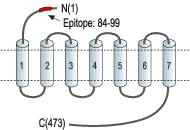Overview
- Peptide NKSLSSFKENEENIQC, corresponding to amino acid residues 84-99 of rat CB1 receptor (Accession P20272). Extracellular, N- terminus.

 Western blot analysis of mouse brain lysates (lanes 1 and 3) and rat brain membranes (lanes 2 and 4):1-2. Guinea Pig Anti-Cannabinoid Receptor 1 (extracellular) Antibody (#ACR-001-GP), (1:400).
Western blot analysis of mouse brain lysates (lanes 1 and 3) and rat brain membranes (lanes 2 and 4):1-2. Guinea Pig Anti-Cannabinoid Receptor 1 (extracellular) Antibody (#ACR-001-GP), (1:400).
3-4. Guinea Pig Anti-Cannabinoid Receptor 1 (extracellular) Antibody (#ACR-001-GP), preincubated with Cannabinoid Receptor 1 (extracellular) Blocking Peptide (#BLP-CR001).
 Expression of Cannabinoid Receptor 1 in mouse hippocampus.Immunohistochemical staining of perfusion-fixed frozen mouse brain sections with Guinea Pig Anti-Cannabinoid Receptor 1 (extracellular) Antibody (#ACR-001-GP), (1:200), followed by goat anti-guinea pig - Alexa Fluor-594. A. Staining in the dentate gyrus region, showed CB1R immunoreactivity (red) in axonal outlines in the outer molecular layer (arrows pointing down) and in the hilus (arrows pointing up). B. Pre-incubation of the antibody with Cannabinoid Receptor 1 (extracellular) Blocking Peptide (#BLP-CR001), suppressed staining. Cell nuclei are stained with DAPI (blue). G = granule layer, H = hilus.
Expression of Cannabinoid Receptor 1 in mouse hippocampus.Immunohistochemical staining of perfusion-fixed frozen mouse brain sections with Guinea Pig Anti-Cannabinoid Receptor 1 (extracellular) Antibody (#ACR-001-GP), (1:200), followed by goat anti-guinea pig - Alexa Fluor-594. A. Staining in the dentate gyrus region, showed CB1R immunoreactivity (red) in axonal outlines in the outer molecular layer (arrows pointing down) and in the hilus (arrows pointing up). B. Pre-incubation of the antibody with Cannabinoid Receptor 1 (extracellular) Blocking Peptide (#BLP-CR001), suppressed staining. Cell nuclei are stained with DAPI (blue). G = granule layer, H = hilus.
- Brooks, J.W. and Fraquhar-Smith, M.A. (2003) Br. J. Anaesth. 3, 175.
- Howlett, A.C. (2002) Prostaglandins Other Lipid Mediat. 68–69, 619.
- Howlett, A.C. et al. (2002) Pharmacol. Rev. 54, 161.
- Rueda, D. et al. (2000) Mol. Pharmacol. 58, 814.
- Sarfaraz, S. et al. (2005) Cancer Res. 65, 1635.
- Casanova, M.L. et al. (2003) J. Clin. Invest. 111, 43.
- Cota, D. et al. (2003) Int. J. Obes. Relat. Metab. Disord. 27, 289.
Cannabinoids have been used in Eastern medicine for many years as pain relievers.1 Δ9-tetrahydrocannabinol (THC), the major psychoactive compound in marijuana and hashish, has been shown to interact with two specific cannabinoid receptors: cannabinoid receptor 1 (CB1 receptor) and cannabinoid receptor 2 (CB2 receptor).2 The cannabinoid receptors can be distinguished by their amino acid sequences, signaling mechanisms, and tissue distributions.2 Both receptors belong to the G-protein coupled receptor (GPCR) superfamily. CB1 was shown to modulate several Ca2+ and K+ ion channels.2,3
CB1 is primarily expressed in the central nervous system. However, expression of CB1 is also detected in the peripheral terminals, in non-neuronal peripheral tissues such as uterus, testes, spleen, as well as in cells of the immune system.3,4
CB1 is implicated in many cellular functions such as neurotransmitter release, pain relief, cancer, and obesity.5,6 Growth inhibition of tumor cells was demonstrated following mixed CB1/CB2 agonist treatment in both prostate and non-melanoma skin cancers.5,6 Through their interaction with CB1, cannabinoid compounds stimulate appetite for sweets and palatable foods in particular, making CB1 an attractive therapeutic target for the treatment of obesity and eating disorders.7
Application key:
Species reactivity key:
Guinea Pig Anti-Cannabinoid Receptor 1 (extracellular) Antibody (#ACR-001-GP) is a highly specific antibody directed against an epitope of the rat protein. The antibody can be used in western blot and immunohistochemistry applications. It has been designed to recognize CB1R from mouse, rat and human samples.

The antigen used to immunize guinea pigs is the same as Anti-Cannabinoid Receptor 1 (extracellular) Antibody (#ACR-001) raised in rabbits. Our line of guinea pig antibodies enables more flexibility with our products such as multiplex staining studies, immunoprecipitation and more.